Screen printing
| Part of a series on the | ||||||||||||||||||||||||||||||||||||||||||||||||
| History of printing | ||||||||||||||||||||||||||||||||||||||||||||||||
|---|---|---|---|---|---|---|---|---|---|---|---|---|---|---|---|---|---|---|---|---|---|---|---|---|---|---|---|---|---|---|---|---|---|---|---|---|---|---|---|---|---|---|---|---|---|---|---|---|
|
||||||||||||||||||||||||||||||||||||||||||||||||

Screen printing is a printing technique that uses a woven mesh to support an ink-blocking stencil to receive a desired image. The attached stencil forms open areas of mesh that transfer ink or other printable materials which can be pressed through the mesh as a sharp-edged image onto a substrate. A fill blade or squeegee is moved across the screen stencil, forcing or pumping ink into the mesh openings for transfer by capillary action during the squeegee stroke. Basically, it is the process of using a stencil to apply ink onto a substrate, whether it be t-shirts, posters, stickers, vinyl, wood, or other material.
Screen printing is also a stencil method of print making in which a design is imposed on a screen of polyester or other fine mesh, with blank areas coated with an impermeable substance. Ink is forced into the mesh openings by the fill blade or squeegee and onto the printing surface during the squeegee stroke. It is also known as silkscreen, serigraphy, and serigraph printing. One colour is printed at a time, so several screens can be used to produce a multicoloured image or design.
Etymology
There are various terms used for what is essentially the same technique. Traditionally the process was called screen printing or silkscreen printing because silk was used in the process prior to the invention of polyester mesh. Currently, synthetic threads are commonly used in the screen printing process. The most popular mesh in general use is made of polyester. There are special-use mesh materials of nylon and stainless steel available to the screen printer. There are also different types of mesh size which will determine the outcome and look of the finished design on the material.
Encyclopedia references, encyclopedias and trade publications also use an array of spellings for this process, with two most often encountered English spellings, the more popular being the two word title screen printing without hyphenation, and less commonly screenprinting spelled as a single undivided word.
History

Screen printing is a form of stencilling that first appeared in a recognizable form in China during the Song Dynasty (960–1279 AD).[1][2] It was then adapted by other Asian countries like Japan, and was furthered by creating newer methods.
Screen printing was largely introduced to Western Europe from Asia sometime in the late 18th century, but did not gain large acceptance or use in Europe until silk mesh was more available for trade from the east and a profitable outlet for the medium discovered.
Early in the 1910s, several printers experimenting with photo-reactive chemicals used the well-known actinic light–activated cross linking or hardening traits of potassium, sodium or ammonium chromate and dichromate chemicals with glues and gelatin compounds. Roy Beck, Charles Peter and Edward Owens studied and experimented with chromic acid salt sensitized emulsions for photo-reactive stencils. This trio of developers would prove to revolutionize the commercial screen printing industry by introducing photo-imaged stencils to the industry, though the acceptance of this method would take many years. Commercial screen printing now uses sensitizers far safer and less toxic than bichromates. Currently there are large selections of pre-sensitized and "user mixed" sensitized emulsion chemicals for creating photo-reactive stencils.[3]
A group of artists who later formed the National Serigraphic Society coined the word Serigraphy in the 1930s to differentiate the artistic application of screen printing from the industrial use of the process.[4] "Serigraphy" is a compound word formed from Latin "sēricum" (silk) and Greek "graphein" (to write or draw).[5]
The Printers' National Environmental Assistance Center says "Screenprinting is arguably the most versatile of all printing processes."[6] Since rudimentary screenprinting materials are so affordable and readily available, it has been used frequently in underground settings and subcultures, and the non-professional look of such DIY culture screenprints have become a significant cultural aesthetic seen on movie posters, record album covers, flyers, shirts, commercial fonts in advertising, in artwork and elsewhere.
History 1960s to present
Credit is generally given to the artist Andy Warhol for popularising screen printing identified as serigraphy, in the United States. Warhol is particularly identified with his 1962 depiction of actress Marilyn Monroe screen printed in garish colours.[7]
American entrepreneur, artist and inventor Michael Vasilantone started to use, develop, and sell a rotary multicolour garment screen printing machine in 1960.[citation needed] Vasilantone later filed for patent[8] on his invention in 1967 granted number 3,427,964 on February 18, 1969.[8] The original rotary machine was manufactured to print logos and team information on bowling garments but soon directed to the new fad of printing on t-shirts. The Vasilantone patent was licensed by multiple manufacturers, the resulting production and boom in printed t-shirts made the rotary garment screen printing machine the most popular device for screen printing in the industry. Screen printing on garments currently accounts for over half of the screen printing activity in the United States.[9]
In June 1986, Marc Tartaglia, Marc Tartaglia Jr. and Michael Tartaglia created a silk screening device which is defined in its US Patent Document as, "Multi-coloured designs are applied on a plurality of textile fabric or sheet materials with a silk screen printer having seven platens arranged in two horizontal rows below a longitudinal heater which is movable across either row." This invention received the patent number 4,671,174 on June 9, 1987, however the patent no longer exists.[citation needed]
Graphic screenprinting is widely used today to create many mass or large batch produced graphics, such as posters or display stands. Full colour prints can be created by printing in CMYK (cyan, magenta, yellow and black ('key')).
Screen printing lends itself well to printing on canvas. Andy Warhol, Rob Ryan, Blexbolex, Arthur Okamura, Robert Rauschenberg, Roy Lichtenstein, Harry Gottlieb, and many other artists have used screen printing as an expression of creativity and artistic vision.
Printing technique

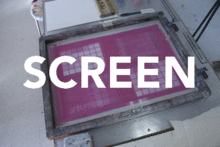

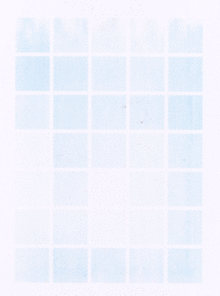






A screen is made of a piece of mesh stretched over a frame. A stencil is formed by blocking off parts of the screen in the negative image of the design to be printed; that is, the open spaces are where the ink will appear on the substrate.
Before printing occurs, the frame and screen must undergo the pre-press process, in which an emulsion is 'scooped' across the mesh and the 'exposure unit' burns away the unnecessary emulsion leaving behind a clean area in the mesh with the identical shape as the desired image. The surface (commonly referred to as a pallet) ensures that the substrate will be printed against is coated with a wide 'pallet tape'. This serves to protect the 'pallet' from any unwanted ink leaking through the substrate and potentially staining the 'pallet' or transferring unwanted ink onto the next substrate. Next, the screen and frame are lined with a tape. The type of tape used in for this purpose often depends upon the ink that is to be printed onto the substrate. These aggressive tapes are generally used for UV and water-based inks due to the inks' lower viscosities. The last process in the 'pre-press' is blocking out any unwanted 'pin-holes' in the emulsion. If these holes are left in the emulsion, the ink will continue through and leave unwanted marks. To block out these holes, materials such as tapes, speciality emulsions and 'block-out pens' may be used effectively.
The screen is placed atop a substrate. Ink is placed on top of the screen, and a floodbar is used to push the ink through the holes in the mesh. The operator begins with the fill bar at the rear of the screen and behind a reservoir of ink. The operator lifts the screen to prevent contact with the substrate and then using a slight amount of downward force pulls the fill bar to the front of the screen. This effectively fills the mesh openings with ink and moves the ink reservoir to the front of the screen. The operator then uses a squeegee (rubber blade) to move the mesh down to the substrate and pushes the squeegee to the rear of the screen. The ink that is in the mesh opening is pumped or squeezed by capillary action to the substrate in a controlled and prescribed amount, i.e. the wet ink deposit is proportional to the thickness of the mesh and or stencil. As the squeegee moves toward the rear of the screen the tension of the mesh pulls the mesh up away from the substrate (called snap-off) leaving the ink upon the substrate surface.
There are three common types of screen printing presses. The 'flat-bed', 'cylinder', and the most widely used type, the 'rotary'.[6]
Textile items printed with multicoloured designs often use a wet on wet technique, or colours dried while on the press, while graphic items are allowed to dry between colours that are then printed with another screen and often in a different colour after the product is re-aligned on the press.
Most screens are ready for re-coating at this stage, but sometimes screens will have to undergo a further step in the reclaiming process called dehazing. This additional step removes haze or "ghost images" left behind in the screen once the emulsion has been removed. Ghost images tend to faintly outline the open areas of previous stencils, hence the name. They are the result of ink residue trapped in the mesh, often in the knuckles of the mesh (the points where threads cross).[10]
While the public thinks of garments in conjunction with screen printing, the technique is used on tens of thousands of items, including decals, clock and watch faces, balloons, and many other products. The technique has even been adapted for more advanced uses, such as laying down conductors and resistors in multi-layer circuits using thin ceramic layers as the substrate.
Stencilling techniques
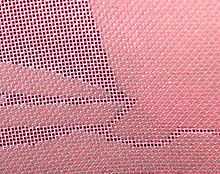
A method of stencilling that has increased in popularity over the past years is the photo emulsion technique:

- The original image is created on a transparent overlay, and the image may be drawn or painted directly on the overlay, photocopied, or printed with a computer printer, but making so that the areas to be inked are not transparent. A black-and-white positive may also be used (projected onto the screen). However, unlike traditional plate-making, these screens are normally exposed by using film positives.
- A screen must then be selected. There are several different mesh counts that can be used depending on the detail of the design being printed. Once a screen is selected, the screen must be coated with emulsion and put to dry in a dark room. Once dry, it is then possible to burn/expose the print.
- The overlay is placed over the screen, and then exposed with a light source containing ultraviolet light in the 350-420 nano meter spectrum.
- The screen is washed off thoroughly. The areas of emulsion that were not exposed to light dissolve and wash away, leaving a negative stencil of the image on the mesh.
Another advantage of screen printing is that large quantities can be produced rapidly with new automatic presses, up to 1800 shirts in 1 hour.[11] The current speed loading record is 1805 shirts printed in one hour, documented on 18 February 2005. Maddie Sikorski of the New Buffalo Shirt Factory in Clarence, New York (USA) set this record at the Image Wear Expo in Orlando, Florida, USA, using a 12-colour M&R Formula Press and an M&R Passport Automatic Textile Unloader. The world speed record represents a speed that is over four times the typical average speed for manual loading of shirts for automated screen printing.[9]
Screen printing materials
- Caviar beads
- A caviar bead is a glue that is printed in the shape of the design, to which small plastic beads are then applied – works well with solid block areas creating an interesting tactile surface.
- Cracking ink
- Cracking ink effect is when the ink produces an intentional cracked surface after drying.
- Discharge inks
- Discharge ink is used to print lighter colours onto dark background fabrics, they work by removing the dye of the garment – this means they leave a much softer texture. The cons with this process is that they are less graphic in nature than plastisol inks, and exact colours are difficult to control. One of the pros of using this process is they are especially good for distressed prints and under-basing on dark garments that are to be printed with additional layers of plastisol. It adds variety to the design or gives it that natural soft feel.
- Expanding ink (puff)
- Expanding ink, or puff, is an additive to plastisol inks which raises the print off the garment, creating a 3D feel and look to the design. Mostly used when printing on apparel.
- Flocking
- Flocking consists of a glue printed onto the fabric and then flock material is applied for a velvet touch.
- Foil
- Foil is much like flock, but instead of a velvet touch and look it has a reflective/mirror look to it. Although foil is finished with a heat press process it needs the screen printing process in order to add the adhesive glue onto the material for the desired logo or design.
- Four colour process or the CMYK colour model
- Four colour process is when the artwork is created and then separated into four colours (CMYK) which combine to create the full spectrum of colours needed for photographic prints. This means a large number of colours can be simulated using only 4 screens, reducing costs, time, and set-up. The inks are required to blend and are more translucent, meaning a compromise with vibrancy of colour.
- Glitter/Shimmer
- Glitter or Shimmer ink is when metallic flakes become an additive in the ink base to create this sparkle effect. Usually available in gold or silver but can be mixed to make most colours.
- Gloss
- Gloss ink is when a clear base laid over previously printed inks to create a shiny finish.
- Metallic
- Metallic ink is similar to glitter, but smaller particles suspended in the ink. A glue is printed onto the fabric, then nano-scale fibers applied on it. This is often purchased already made.
- Mirrored silver
- Mirrored silver is a highly reflective, solvent based ink.
- Nylobond
- Nylobond is a special ink additive for printing onto technical or waterproof fabrics.
- Plastisol
- Plastisol is the most common ink used in commercial garment decoration. Good colour opacity onto dark garments and clear graphic detail with, as the name suggests, a more plasticized texture. This print can be made softer with special additives or heavier by adding extra layers of ink. Plastisol inks require heat (approx. 150°C (300°F) for many inks) to cure the print.
- PVC and Phthalate Free
- PVC and Phthalate Free is relatively new breed of ink and printing with the benefits of plastisol but without the two main toxic components. It also has a soft texture.
- Suede Ink
- Suede ink is a milky coloured additive that is added to plastisol. With suede additive you can make any color of plastisol have a suede feel. It is actually a puff blowing agent that does not bubble as much as regular puff ink. The directions vary from manufacturer to manufacturer, but generally up to 50% suede can be added to normal plastisol.
- Water-Based inks
- these penetrate the fabric more than the plastisol inks and create a much softer feel. Ideal for printing darker inks onto lighter coloured garments. Also useful for larger area prints where texture is important. Some inks require heat or an added catalyst to make the print permanent.
Versatility

Screen printing is more versatile than traditional printing techniques. The surface does not have to be printed under pressure, unlike etching or lithography, and it does not have to be planar. Different inks can be used to work with a variety of materials, such as textiles, ceramics, wood, paper, glass, metal, and plastic. As a result, screen printing is used in many different industries, including:
- Balloons
- Clothing
- Decals
- Medical devices
- Printed electronics, including circuit board printing
- Product labels
- Signs and displays
- Snowboard graphics
- Textile fabric
- Thick film technology
Semiconducting material
In screen printing on wafer-based solar photovoltaic (PV) cells, the mesh and buses of silver are printed on the front; furthermore, the buses of silver are printed on the back. Subsequently, aluminum paste is dispensed over the whole surface of the back for passivation and surface reflection.[12] One of the parameters that can vary and can be controlled in screen printing is the thickness of the print. This makes it useful for some of the techniques of printing solar cells, electronics etc.
One of the most critical processes to maintain high yield. Solar wafers are becoming thinner and larger, so careful printing is required to maintain a lower breakage rate. On the other hand, high throughput at the printing stage improves the throughput of the whole cell production line.[12]
Screen printing press
To print multiple copies of the screen design on garments in an efficient manner, amateur and professional printers usually use a screen printing press. Many companies offer simple to sophisticated printing presses. Most of these presses are manual. A few that are industrial-grade-automatic printers require minimal manual labor and increase production significantly.
Rotary screen printing
A development of screen printing with flat screens from 1963 was to wrap the screen around to form a tube, with the ink supply and squeegee inside the tube. The resulting roller rotates at the same speed as the web in a roll-to-roll machine. The benefits are high output rates and long rolls of product. This is the only way to make high-build fully patterned printing/coating as a continuous process, and has been widely used for manufacturing textured wallpapers.[13] A large number of such machines have been supplied by Stork B.V..[14]
Example images
See also
- Dye
- Glass
- Gocco
- Ink jet
- Multi-layer
- Metal
- Plastic
- Printed electronics
- Printed T-shirt
- Roll-to-roll printing
- Seriolithograph
- Svecia screen printing machines
- Textile printing
Notes
- ↑ http://www.jstor.org/pss/4629553
- ↑ "History's Influence on Screen Printing's Future | ScreenWeb". screenweb.com. 2006-05-04. Retrieved 2012-11-15.
- ↑ "screenprinting". Homepage.usask.ca. Retrieved 2012-11-15.
- ↑ "Serigraphy, screen prints, art". Home.earthlink.net. Retrieved 2012-11-15.
- ↑ "Serigraphy | Define Serigraphy at Dictionary.com". Dictionary.reference.com. Retrieved 2012-11-15.
- ↑ 6.0 6.1 "Printer's National Environmental Assistance Center Official website". Retrieved 2007-09-15.
- ↑ "Andy Warhol's Marilyn Prints". Webexhibits.org. Retrieved 2012-11-15.
- ↑ 8.0 8.1 "patft » Page 1 of 1". Patft.uspto.gov. 2010-08-26. Retrieved 2012-11-15.
- ↑ 9.0 9.1 "Industry Analysis". Sgia.org. Retrieved 2012-11-15.
- ↑ "Putting Your Reclaiming Tools to Work: Reclaiming Screens to Maximize Your Profits (Part 2)". Signindustry.com. Retrieved 2013-11-27.
- ↑ "The M&R Companies :: News - M&R-and-Maddie-Sikorski-set-World-Record". Mrprint.com. 2005-02-18. Retrieved 2012-11-15.
- ↑ 12.0 12.1 "Screen printing - Front End Omron Wafer Based PV". Omron-semi-pv.eu. Retrieved 2012-11-15.
- ↑
- ↑ "Rotary screens - Areas of expertise". SPGPrints. 2008-12-24. Retrieved 2013-11-27.
Further reading
- Jacob I. Biegeleisen: Screen Printing: A Contemporary Guide. – New-York, 1972.
- Andy MacDougall: Screen Printing Today: The Basics. – ST-Media, Cincinnati, 2008.
- Guido Lengwiler: A History of Screen Printing. – ST-Media, Cincinnati, 2013.
External links
| Wikimedia Commons has media related to Screen printing. |
- American Screen Printing Association, Inc.
- The Federation of European Screen Printers Associations
- Who’s Who in Screenprinting
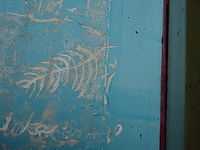
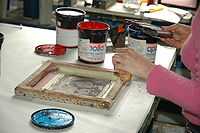

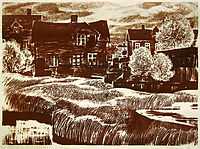





.jpg)
